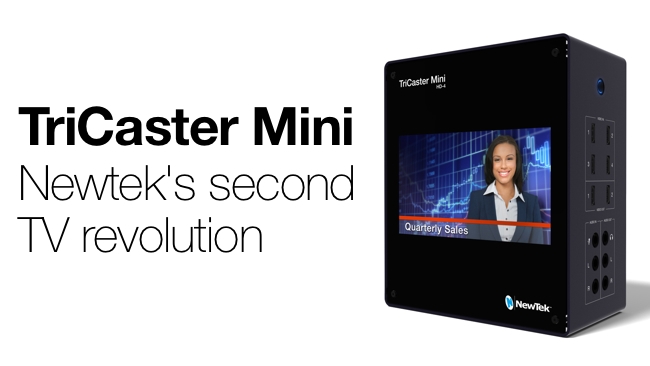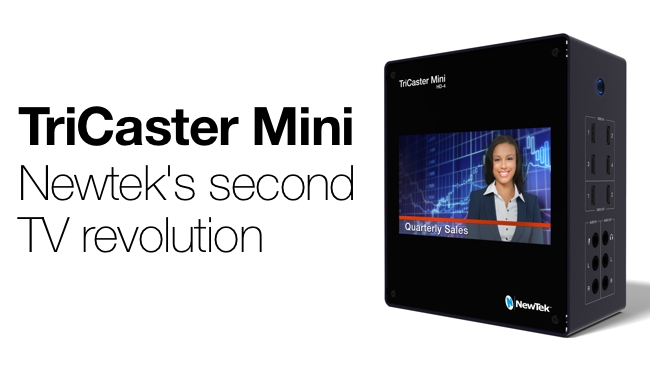
 TriCaster Mini
TriCaster Mini
Newtek has just announced the TriCaster Mini. It's a self-contained version of their TriCaster Live Production System that has HDMI inputs instead of HDSDI, and which, in one, small, self-contained box (no need for a host computer) has all the software you need to create network-quality TV shows and record or stream them live.
We think this is a very big deal because video communication (ie using video to get your message across) is about to explode. It's by far the most effective way to engage viewers, and with the abundance of ways to distribute video (streaming to phones and tablets, for example) it's never been a better time for a product like this.
The TriCaster Mini is for people who want to add video content and live streaming but who don't produce video for a living and who don't have the "language" of broadcasting.
TriCaster lowers barriers
Newtek's TriCaster has lowered barriers to live (and live-style) TV production since its introduction in 2005. It's probably fair to say that it has revolutionized live TV production and, as it has matured, it has continued to add features that are relevant and necessary to create modern-looking TV programs. Today it's an extremely impressive product, and anyone who hasn't seen it for a while is likely to be blown away by the feature set.
With it you can create live TV shows that look like they've come from a network TV studio, complete with titles, backgrounds, animations, transitions and literally everything else you need to make a convincing-looking TV program.
You still need all the stuff that comes with live TV production, though, including lights and cameras. Scenery is less of an issue because of the "virtual studio" capabilities of the TriCaster, but studio-type TV cameras are still relatively expensive, and knowing how to set up a complete studio is still beyond anyone who, well, doesn't know how to set up a studio.
It's not just this that's getting in the way of making professional video. There is an aura of technical know how, perceived high cost, and perceived complexity that keeps non-video pros from investing in video production in the enterprise world.
Which is a pity, because there's never been a time when professional-looking video presentations have been more in demand. It's widely accepted that video content is an (if not the most) important part of "content marketing"; a new concept in marketing that gives potential customers the sense that they've gained something (knowledge or maybe even just entertainment) from reading or watching something on your website or blog. Make no mistake: content marketing is big. As consumers get tired of "conventional" advertising, content marketing resets the contract between provider and consumer, in a way that is beneficial to all parties.
Beyond marketing, video is proven to be one of the most effective channels for communicating ideas.
The existing broadcasters and production companies have the high end well covered. They have the budgets, the skills, the equipment and the talent. But, unfortunately, that rules out a much larger group of potential videomakers who have the ideas and the motivation, but lack the other elements.
The plain fact is that up to now, it's been too difficult to create television-style programs. For video blogs and short presentations, a simple, single camera approach is fine, but for anything beyond that - for anything that needs to look more professional or more like a network TV show, with all the bells and whistles - then, up to now, you will have needed at least the services of a fully-fledged TriCaster.
And that's fine. That product will continue to flourish, because there's an established market out there. But what about the next level down, where there is neither the professional equipment, nor the know-how to go with it?
The new TriCaster Mini
This is where NewTek has stepped in, today, with their new product, the TriCaster Mini.
Aimed at pretty much anyone that seriously needs to produce television programs, the new all-in-one device retains the smartness and power of the full sized TriCaster (it runs the same "professional" software) but it eases users into the inevitably complex process of TV production by making things easier to set up, and by allowing the use of "non-professional" cameras: specifically those with HDMI outputs. There are two versions: one has more storage and a built in screen.
This is a very big deal, because it lowers the cost of multi-camera production enormously.
In fact, there has never been such a proliferation of low cost cameras that could be used with the new TriCaster. Virtually any video camera or DSLR with an HDMI output will do the job (you will need to make sure that the HDMI output is "clean" - ie that it doesn't have an overlay of viewfinder info in it, but most modern cameras will be suitable.)
You could even use a Blackmagic Pocket Cinema Camera. These give a great-looking output for studio use - you just have to make sure that the output is set to "video" as opposed to "film" look.
Pricing (see press release over the page) is set to be affordable to professionals and organisations who want to make video content.
We'll be trying one of these out next week, so watch out for our report. Meanwhile, here's Newtek's press release in full.
NewTek Unveils the Most Complete, Compact Multimedia Studio in the World: TriCaster Mini
––Allows anyone to set up and create network-style TV content in minutes––
SAN ANTONIO, USA - 7 October 2014––NewTek™ today unveiled TriCaster Mini™––the world’s most complete and compact multimedia studio. The ultra-portable system allows anyone who doesn’t speak or understand the technical language of video production or broadcasting to transform an ordinary presentation into engaging multimedia content that looks like network-style TV in a matter of minutes. Marketers, corporate employees, small business managers, community administrators, educators, trainers, non-profit and worship service volunteers, and entertainers who are interested in delivering their messages like seasoned television professionals can now use TriCaster Mini to assemble visually sophisticated multimedia presentations - and stream them live, publish to social media or upload to a website from the office, an event, or any location with an Internet connection. The tiny, sleek design, support for virtually any camera, and comprehensive toolset make TriCaster Mini easy to carry in one hand, setup, create and share content.
“With TriCaster Mini, we have built a product that gives anyone wishing to use video to communicate with others the ability to create content that looks like professionally made television in minutes where traditionally it took hours or days. Our goal is to dispel the myth that it’s too technologically difficult or expensive to produce engaging multimedia content, and we’ve achieved that with TriCaster Mini,” said Dr. Andrew Cross, president and chief technical officer for NewTek. “Video is the fastest growing and most compelling communication medium in history, and to stay relevant, people in all areas are finding it increasingly important to conduct video interviews, webcasts, and presentations that mix slides, video clips, graphics and more. No other system in the world makes it as easy for anyone to get started than TriCaster Mini.”
TriCaster Mini: Small, Sleek and Exceptionally Simple
Anyone familiar with computer software and has access to one or more cameras can use TriCaster Mini to capture and mix multiple live video camera angles with graphics, video clips, audio, titles and special effects. Setup is fast, straightforward and uncomplicated, and within a matter of minutes, users can create a multimedia programme that looks professional without any other broadcast studio equipment or a professional crew. An integrated and configurable video screen on the side of the system also serves as a monitor for displaying a range of content selected by the user.
As newcomers become more comfortable with multimedia presentations, they can further explore a wide range of creative tools that come standard with TriCaster Mini, including:
Mix different visual sources
Overlay logos, presentations, charts, titles, media files, animations
Import your own branding elements and have them appear in transitions and animations
Incorporate a slideshow, web-pages from another computer
Replace solid backgrounds with a simulated environment
Webcast programmes on a live video stream
Post clips to YouTube, Facebook and Twitter, your web site
Have guest speakers call in from their webcams
Record the programme so people can watch it on-demand
Record all camera footage simultaneously so you can edit the programme
Make keyboard shortcuts for sophisticated sequences with one touch
Pricing and Availability
TriCaster Mini, including the integrated display screen and system storage capable of recording approximately 45 hours of footage, is available immediately for $7,995 USMSRP. TriCaster Mini is also available without the integrated display screen and system storage capable of recording approximately 15 hours of footage for $5,995 USMSRP. An optional control surface is available for $2,495 USMSRP, and an optional TriCaster Mini cable-kit with four 100-foot HDMI cables is also available for $495 USMSRP.
International pricing will vary.
For more information on all NewTek products, please visit www.newtek.com.
About NewTek
NewTek is transforming the way people create network-style television content and share it with the world. From sporting events, Web-based talk shows, live entertainment, classrooms, and corporate communications—to virtually any venue where people want to capture and publish live video, we give our customers the power to grow their audiences, brands and businesses, faster than ever before.
Clients include: Pinewood Studios, Arsenal TV, Derby County FC, Mustard TV, 3xScreen Media, “The X Factor,” New York Giants, NBA Development League, Fox News, BBC, NHL, Nickelodeon, CBS Radio, ESPN Radio, Fox Sports, MTV, TWiT.TV, USA TODAY, Department of Homeland Security (DHS), the National Aeronautics and Space Administration (NASA), and more than 80% of the U.S. Fortune 100.
Tags: Technology


Comments